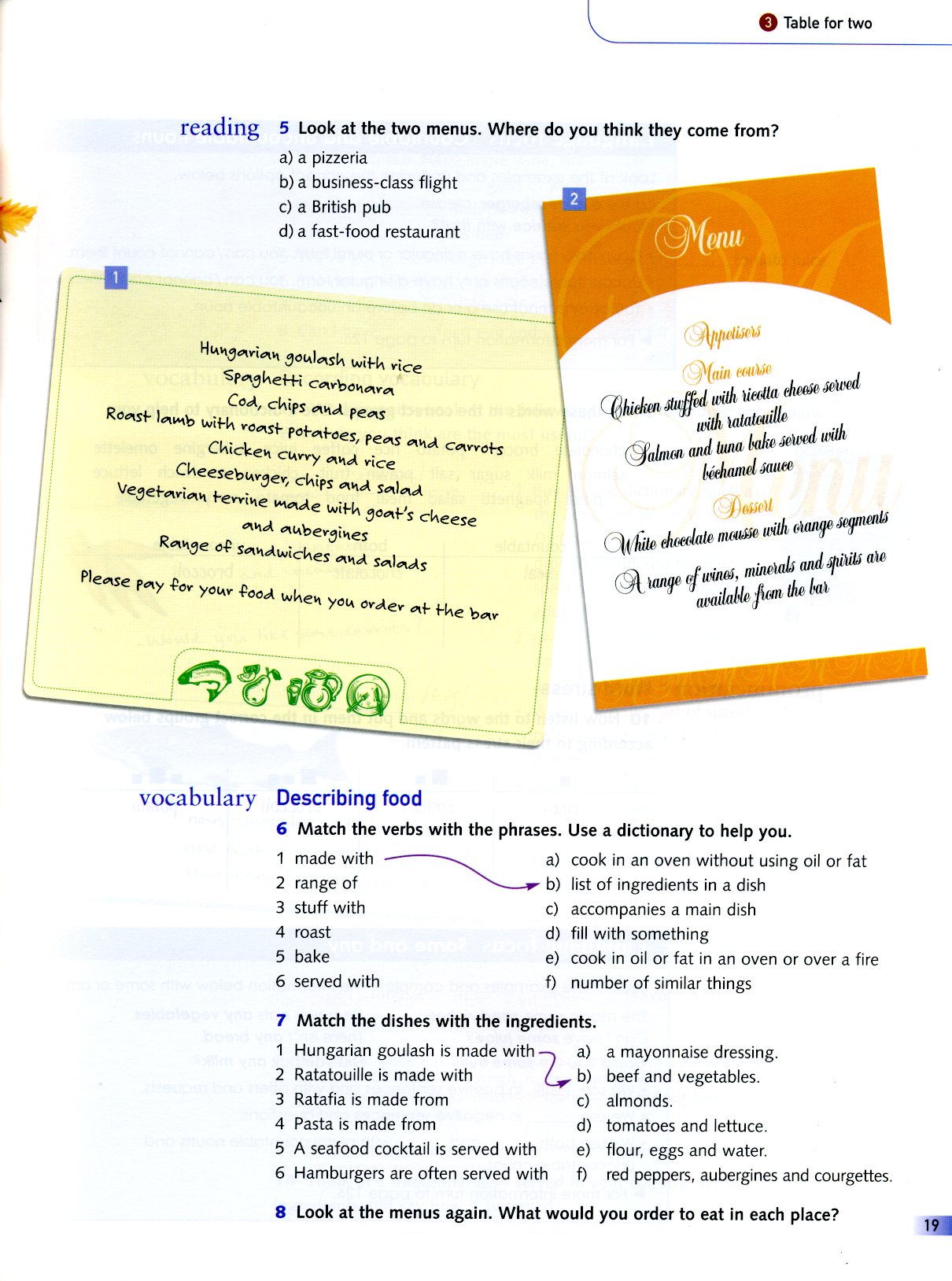89006 img466 (8)

© Table for two
reading 5 Look at the two menus. Where do you think they come from?
a) a pizzeria
b) a business-class flight
c) a British pub
d) a fast-food restaurant
goid^nsU wit-U r\ce. ■Sp^gUeH-i C<*.r\>OV\eĄYć*.
CcA, cUips pe<*s mb wtł-Uk v-o<*sf poł-^foes, pems ćah.
CUeesebiAvgev, cUlps scn)*n<A ,v'u*.n ł-evviv\e m^e wit-U c
inna ^lAbe^i^es
)(ain mW>
ieken Jlupfed willi MMa ehmSe Mved mil kdałmlk
( jalnm and luna kdwMoed mili tóekamelsaueo
(df)mu
1 \( hilc ehmlale nwitSfe with o)an<ff M/nmli ' :Ą Uuige (fwinaJ, mineiab and ifu\iti a\o
amilaIŁ pan l/w tai
vocabulary Describing food
6 Match the verbs with the phrases. Use a dictionary to help you.
1 madę with ----a) cook in an oven without using oil or fat
2 rangę of —w b) list of ingredients in a dish
3 stuff with c) accompanies a main dish
4 roast d) fili with something
5 bakę e) cook in oil or fat in an oven or over a fire
6 served with f) number of similar things
7 Match the dishes with the ingredients.
1 Hungarian goulash is madę with—> a)
5 A seafood cocktail is served with e)
6 Hamburgers are often served with f)
a mayonnaise dressing. beef and vegetables. almonds.
tomatoes and lettuce. flour, eggs and water. red peppers, aubergines and courgettes.
8 Look at the menus again. What would you order to eat in each place?
19
Wyszukiwarka
Podobne podstrony:
a) What s on at the Electric Cinema? b) What do you think of hor
math patterns2(1) ^.KidZone.^ Name: _ _ math readiness Look at the pattern in each row. Circle the p
Obraz0021 LisfeningTest<sPART 1 You will hear seven department storę announcements. For questions
WELCOME 1 ĆWICZENIA 46 Ml s fi ssisi5 Look at the pictures and write about you. 1 &nb
table vpeoyi7fhijchgl Caller: You look ihrough the paper and whai do you see? John Shark: 1 don i k
The Legend of the?ndy?ne CtimĆmdfeThe Legend of the Candy Cane Look at a candy oane and whaf do you
scan0002 (6) d Look at the two versions of her CV that Silvia prepared. Which approach has she follo
16 READING Gap filiTOPIĆ Culture EXAM TIPS ► Before you read the text, look at the
Ensino da geografia: caminhos e encantos PDF eBooks Download do nothing, For instance they take a lo
skanuj0087 SuperKids ChampionAnswer KeyWord for Word 1 Look at the pictures on p.
File0045 undcrsttmd informatioK iit a tourist guide.. Monumental gifts 1 Look at the reading tip bel
img465 (8) Table for two Table for two speakillg 1 Match the dishes with the pictures. Phanaeng curr
więcej podobnych podstron